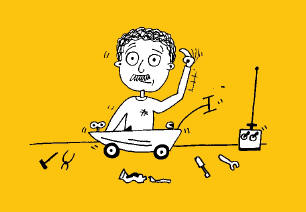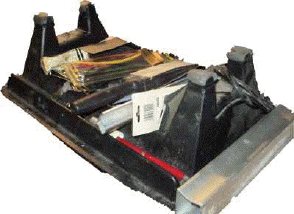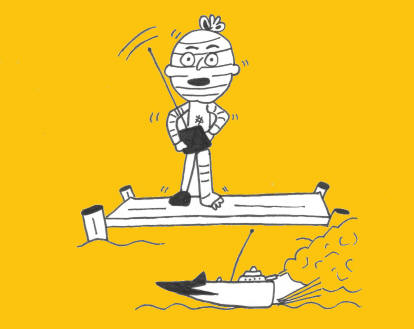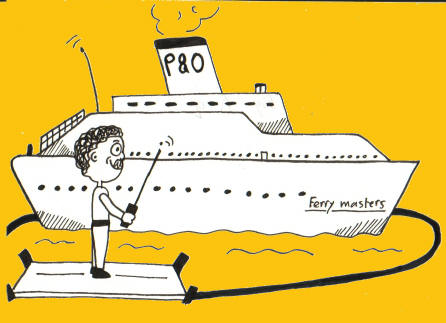|
STARTING IN |
|||
|
By Martin
Davis
" I consider myself an expert to the matter of building model speed boats, on the principal that if we learn from our mistakes, then I'm the worlds smartest guy!"
Martin Davis -every single day! |
|||
 |
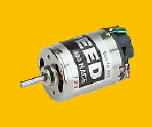 |
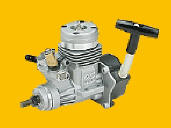 |
 |
| Starting out | Electric Motors | IC engines |
Boat
types |
|
So you want to build yourself a nice model sports boat? |
|||
|
How
much will that model boat cost to put on the water? |
|||
| MY STORY | |||
|
My dealings with model boats began at Whitestone pond, Hampstead Heath, NW London, a historic spot for model boats. I always wanted my Dad to stop whenever driving pass so I could watch them. I recall one time I tried my own clockwork boat on said pond but it didn't work a lick as rust had caused premature rigormortis of the motor from previously testing the boat in the bath. Now I'm all grown up I have my own flotilla of radio controlled speed boats. One of these days, I'm going to make a pilgrimage to Whitestone pond to inspire other youngsters to have a go at boat modelling. |
|||
|
I didn't
have much to do with model boats for many years after that, mainly
due to my lack of pocket money, then some years ago my interest was
rekindled when a friend informed me of an advert in a local sweetshop for
a radio controlled model plane. "Sounds like a good idea", I said to
myself, out of earshot of my wife. After a few days I had bought
a poorly built trainer type aeroplane but with a new two channel
radio (Acoms 27MHz) and new ENYA 3.5cc
aero engine. "This'll
never fly", I said to myself as I handed over the cash and carried
away the bits in a box.
I decided the plane was beyond help and was eventually
laid to rest in my wheely bin, however the radio and engine etc. were
in good condition and could be utilized in another type of model a boat
for example. (Model boat can use the same type of radio and the engine
was later part exchanged for a water-cooled version.) I chose a model
boat as at the time radio controlled cars were all the rage and I
wanted to do something a little different. A boat would give me a good
excuse to spend time in a my lovely park (Ferry
Meadows, Peterborough) in the green grass, next to a
silvery lake amongst the wonderful wildlife and sunny skies above.
What it's really like..... I'll tell you later. |
|||
|
I then
had to decide what sort of boat I wanted. A really fast
IC (Internal Combustion) boat was the most appealing but I changed my
mind on the advice of Ron Dean, proprietor of the local
DEAN'S MARINE workshop.
"Electric boats are a lot less hassle than IC boats, just switch them
on and go". DEAN's MARINE
make a large range of warships launches and merchant ships but I wanted
something faster. So I set about looking for my first fast electric
boat kit. My wife and I thought "One boat and that would be it" ...
WRONG! |
|||
| FIRST THINGS FIRST | |||
|
|
|||
|
But before buying
anything, get yourself some reading material. Some
good books are
Model Boats by John Cundell, Power Boat Modelling by
David Thomas,
Advanced R/C boat modelling by John Finch and of course
Model Boat magazine every month. Some of the model manufactures
catalogues are well worth getting hold off especially the
Robbe
and Graupner ones which are as big as doorsteps but contain
loads of interesting stuff about all types of models. Also worth
looking out for are the
RS components,
Maplin and
Tandy catalogues
and websites
as these have every electronic component & tool
imaginable and quite a few unimaginable ones as well! |
|||
|
Your
nearest
model shop is the best place to purchase your first kits as you can see
the kit "in the flesh" so-to-speak and you can call upon the retailers
experience and local knowledge. I used to do a lot of driving as part of my job
so I got get good idea what's available where and who has the best deal,
it's worth comparing prices. These day, finding out about most
kits can be found about on the web. The model magazines have very
useful adverts and reviews that let you know what's available. Model shows come round several times a year where if you're
real lucky, you may pick up a bargain. At shows always make sure
you get a proper receipt and an address in case of problems or you
just want to buy more goods of them at a later date. I should point
out at this point that sports boats are not a gold bond investment and
on the second hand market they rarely reach their original cost price
but you can't put a price on enjoyment and sense or achievement can you. |
|||
|
Next thing to do
is locate the
nearest model boat club and find out when and where
they meet. The members of the local club are a good source of
information and always welcome newcomers. You may have
search for the right club if you want to do
a specific type of modelling as some clubs don't cater for IC
boats. Don't be too surprised if you find out that some of us
modellers are a little "eccentric" as we tend to spend a lot
of time alone hunched over our latest masterpiece. Sometimes we just
talk too much, just 'take us with a pinch of
salt', one day, if you catch the 'bug', you'll be
just the same! |
|||
| WHAT WILL YOU NEED | |||
|
There are just a few
things you will need, they are...
Unfortunately I have
none of the above and yet
still I manage to build and run my model boats. |
|||
| YOUR FIRST KIT | |||
|
Once
you have decided on the kit you want and given all your hard earned
cash to the model shop, the next thing to do is sneak it
into the house during the middle of the night without
your wife (or husband) finding out. Later,
when asked you can say "I've had it for ages!!" Well that's
what my wife says when I see a new dress! Open your box
of goodies and lay everything out on a table and
check that everything that should be there is there. To
do this you'll need to find the parts list. All good
manufactures provide a parts listing, if not, you'll have to work
out the parts list from the plans sheet. If it doesn't
have a plan, you should have bought a better kit! |
|||
|
The
quality of plans and instructions varies greatly from manufacturer to
manufacturer, some only throw in a few bad photo copied
sheets. The best plans I've come across are in the
German Robbe kits, these have a full size plan with
cross sections and a stage by stage construction book with
complete plan references and even colour photos on the box. Sometimes
you get a extra free giggle from the German to English
translations. When I had the spare room I used to pin the plan
to the wall behind me and the work bench so that I have to
get up to check measurements etc, it's the only physical exercise I
got. |
|||
|
Back to your
kit, identify each part with the list or plan, check it's all there
and examine parts for flaws. Check the wooden parts are
of good quality and are not split or anything.
Look at each part until you are familiar with it so you know where
and how it fits in the model. As you look at each part
try to work out how and when it needs to be fitted, what glue
or fixing is required and if
access is required to it for maintenance
once in place. |
|||
|
If
everything is there then make a list of the bits
you'll need to complete the model and buy them as you need
them or can afford them, fittings, stand, etc. Plan your
complete model from the moment you decide to buy it.
What radio equipment, motor, speed controller,
batteries, engine, fuel tank etc. Buying most things at once can be
useful as a retailer might be more inclined to offer you a
"complete deal" price. Only buy what you need as I've got
kits, motors, engines, fuel tanks, tools,
etc. etc. all over the place that seemed like a good buy
while in the shop. Do you know anyone that wants to buy some
unused model gear? One careful owner! |
|||
| BUILDING | |||
|
To support my boats while working on them I use a MRM plastic glider stand that I got it for a fiver from Pardon Mill models in Harlow. This stand allows almost total access to the hull while building and it suits any shape of hull and had a useful tool tray underneath. Most kits still do not come with a storage stand, for a few extra quid the parts for even a temporary wood stand could be included which would be most beneficial. Each boat will needs it's own boat stand, for storage or start the engine on IC boats. Most plans provide you with the outlines for a suitable stand so you can build your own, unfortunately when I start work on a new boat the stand is not the most interesting bit to start with but it is the most necessary.
|
|||
| Choice of glue is MOST important. Get a lot of advice on this subject. A wrong choice could be instrumental in reproducing a kit of parts again if you bash your boat. For general use there are lots of Superglues around. Superglue accelerators are useful but tend to make the joint a little brittle. For plastic ABS boats the best glue is Stabilit Express, an epoxy type adhesive. Stabilit is really good stuff but cost an-arm-and-a-leg! There are a lot of other epoxy type glues around, Araldite and Devcon come to mind, check the instructions for application particularly for use on ABS plastic. On fibre glass, any of the multi boats suppliers stock a number of useful resins based mixes but you can also use two part epoxy and body work repair kits from car accessory shops. For wood Cascamite is usually the first choice followed by white PVA water resistant glues. Car body filler is also useful as a glue as it holds to most hard materials and doesn't need a flat surface. | |||
| BUILD 'GETABILITY' | |||
|
|
|||
|
Murphy law . 1: If something can go wrong it will. 2: The more critical the part is, the greater the chance that it will fail. 3 : The less likely it is to go wrong, the quicker it will go wrong.
One of the most
annoying things that can happen is something breaking or
failing before the boat even get on the water. If you think
"that'll do", nine times out of ten it won't. If you are
going to make your own parts then use the
Victorian engineering principle, 'make it
ten times stronger than it possibly needs to be'. Sometimes
it's simpler, quicker and cost effective to buy commercial parts
because if your home made part fails you may have go to out
and buy one anyway. |
|||
|
While
building, keep thinking of the boat as a whole, I've built parts for
boats and then found that it won't work with something else eg.
engine mount and exhaust can't fit through the deck opening or you
can't get to some screws once the deck is glued down. Plan ahead,
measure everything out on the plan, use paper templates and make small
pilot holes before drilling the full size ones to check things will
correctly line up. The less flash gimmicks you have on the boat, the
less there is to go wrong, don't make things unnecessarily complicated
just for the sake of it. Buy good engines, ones that you can get
spares for. Don't always take a shopkeeper word that engine parts
ten-a-penny, if he's trying to sell his "Supercharged OkiCoky
5.3.2cc" engine at a special price. |
|||
| FINISHED? | |||
|
|
|||
| KEEPING ABOVE THE WAVES | |||
|
You
can never have too much buoyancy in a speed boat. Fast speed
boats splash a lot of water around and quite a bit
can find it's way inside the hull. Place
buoyancy in both the bow and stern of your boat and in the detachable
cover or hatch. With buoyancy at both ends then
most of the boat will remain above water if disaster
strikes, the boat will also be easier and quicker to
recover. Plumbers insulation foam in cans from DIY shops
is very good buoyancy and also strengthens the
bows. Great care must be taken when
filling your boat with this stuff as the foam will expand many times
it's original volume with a vengeance and pushes aside all
before it. I've ballooned the front of two of my boats by
thinking the foam had stopped expanding only to find it had
only slowed down. Always leave a large hole
if filling behind a bulkhead to allow the access foam and
gases to escape. To fill the bow, stand the
boat on it's nose so the hole in the front bulkhead is
uppermost, vice versa for the stern. A
week is a safe bet that the foam
has stopped expanding at room temperature.
By the way, once this stuff touches anything you'll
NEVER get it off. You can also use different things for
buoyancy such as bubble wrap, expanded polystyrene, packing
"Quavers", air bags etc. but only expanding
foam gives you extra strength but at the cost of extra weight.
Never trust a sealed air tight compartment as adequate
buoyancy, they always seem to leak. At the lake, keep a
constant watch out for impending doom as a little
carelessness might see all that money you couldn't
really afford, heading for the bottom. |
|||
| RADIO IN CONTROL? | |||
|
|
|||
|
The radio is the most important part of the model boat believe it or not, but some people give it less than the required attention. Install and test everything at home first and then re-check everything again on the lake when no one else is about. Don't switch on without checking the band is clear, Check the club peg-board or ask other boaters what band they are on and if busy wait your turn. I Failed to do this a little while ago, I nearly ended up with a black eye! If a fast boat breaks loose from it's master, they can do a lot of damage. Don't take chances, PLAY SAFE. |
|||
|
Some modellers remove the return spring from the
throttle stick, this can be useful during long races, personally I
don't as I prefer the boat to stop or slow to an idle if I
accidentally drop the transmitter... in the water. Yes, I
did once, in my early days. I was bringing a boat in, I put the
control on the jetty and reached down for the
boat and the transmitter fell in the water,
the boat went mad, shot forward, broke my legs in
22 places and had to be amputated just below the neck! |
|||
|
Links from servos must
never be sloppy, they never work properly and are unreliable. Metal
to metal joints always cause radio interference and drive your servos
crazy, use plastic cleveses. The rudder usually puts
the most stress on a servo and on really fast boats,
high power servos could be required. Use two links to your rudder
tiller arm where possible which will provide extra strength
and safety. I've tried both plastic and steel snakes or
Bowden cables, I've found metal ones are more reliable.
Use snakes and cables in pairs, i.e. in pull-pull mode
as snakes aren't very good at pushing. Water-proof servos are a good
idea if you can afford them, but a lot of people use a
water tight radio box especially if using an electronic speed
controller. |
|||
|
I always use
NiCad
batteries in my radio gear as after two or three
re-charges the batteries have paid for themselves.
All my boats have the receiver batteries soldered together,
covered in heat shrink plastic and plug into the
receiver with a charging jack and on/off switch. The subject
of electric motors, IC engines, radios and batteries will be covered
in more detail
- HERE. |
|||
| BURNING YOUR FINGERS ....ONLY ONCE ! | |||
|
|
|||
|
You'll need to read up on the safe use of certain things
such as Superglue, nicads, engines and two-stroke fuel because
although these are safe they require respectful handling. For example,
don't use Superglue and then pick your nose, or smoke while
fuelling up your boat. Quite seriously,
Superglue contains cyanide and two stroke fuel burns with an
almost invisible flame. Be cautious of any propeller because even a
cheap electric motor can rev at 10,000 RPM and can take
a finger off without slowing down. IC engines get
very hot, if you forget, an exhaust pipe will quickly
remind you. Work in a well ventilated area when using any chemicals.
Have a first-aid kit handy at all times, at home and by the lake and
keep a fire extinguisher in your workshop or shed just in
case you have a bad day. Common sense is not all that common so
just a second or two of extra thought will save you time, blood,
money or all three. |
|||
|
CRAFTSMANSHIP. |
|||
|
When you have finished everything, polish all parts of
your sports boat's hull to a mirror finish thus minimizing the water
drag. This will make your boat go faster. Use Brasso
on all the metal work and T-Cut ( car bodywork paint cutter ) on the
hull. Blobs of glue, a bad paint job and rough surfaces on the hull will
rob you of speed and control. |
|||
| A FEW THINGS TO KEEP IN MIND | |||
|
Don't mistake belligerence or confidence for true expertise. In my experience, hydrodynamic theory is almost unheard of in the world of fast model boats and very seldom quoted or practiced, more a case of suck-it-and see and " It won didn't it! ".
Don't be
talked in to something you don't really want to build but
do listen to experience. |
|||
| HAVING FUN | |||
|
Model boats are meant to be fun but some people take it far too seriously. They can get very upset when they loose a race or a competition on a judges decision or because another competitor crashed into you. Model boats, whether fast or slow, are always at some sort of risk, you know that. Really it not that serious, even if it took you 10 years to build at a cost of £10,000. Unfortunately, there are much more important things in life to get upset about. |
|||
|
|
|||
|
There
are many different aspects of model boating and we all choose
our which area we like. It's really narrow
minded to say someone's else's boat isn't a real model
boat just because it's something we personally
wouldn't have touched with a barge pole.
Look at their boat and appreciate the
work that they have put into it, offer advice if you know what
you're talking about and lend a hand if they need it. At club level,
all aspects of boat modelling should be encouraged. Let us all
enjoy our hobby both as individuals and as a group. One
day sooner or later when you take the
boat home with expensive damage or in a plastic bag, try
to remember the whole object of the hobby was a relaxing pastime.
And dispute what my wife and kids think, my model boats ARE NOT
TOYS!!! |
|||
|
EPILOGUE |
|||
|
It
has been said that model boats is the lowest form of
radio control modelling because "if it floats, it
works!" Model cars demand good driving skills and lightning
reactions to stay on the track. Getting model planes in the
air is hard enough, landing them in one piece is almost impossible.
Model helicopters pilots need to be real helicopter pilots!
Model boats and sports boats in particular are so easy in
comparison to other r/c disciplines, it's slightly
embarrassing. They go forwards, turn left and right,
some even go backwards and there's a very good chance
that you'll take it home with you in one piece.... but I
think they're great. At the last count I've owned
and run twenty eight boats and I'm still building. Please buy
one off me before the wife throws me out of HER house! |
|||
|
With thanks... |
|||
|
Well all of this is
just my opinion, but what do I know! |
|||
|
Further surfing... Mayhem Technical Pages www.gettingstartedinrc.com/boats/index.asp |
|||
|
|
|||



